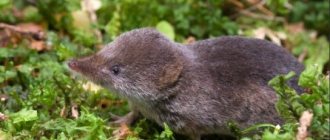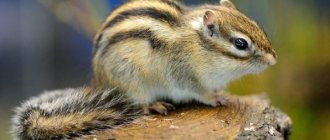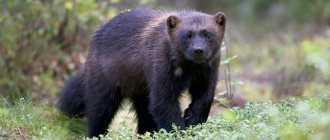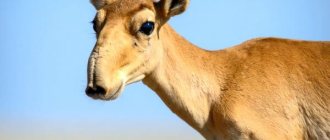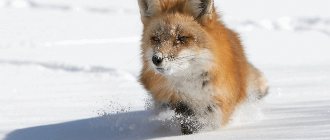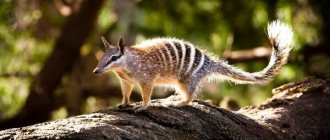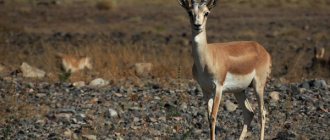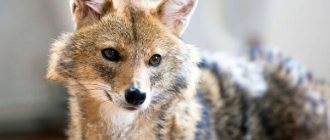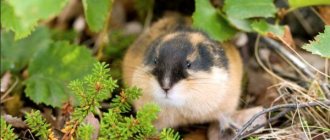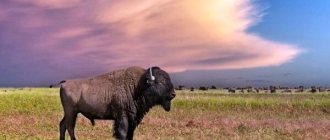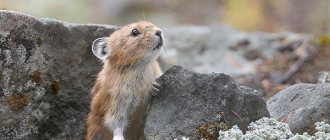The red deer is an animal that belongs to one of the eastern species of deer. It can be found in Korea, as well as in China and Russia. The difference between wapiti and deer is almost imperceptible. Their horns are so strong and powerful that they can use them to kill a predator. The red deer is a large, artiodactyl animal. The weight of red deer in autumn can reach up to half a ton. Its height reaches 1.6 m. The muzzle is wide and long, in females it is more refined and thin.
The wapiti themselves are slender and elegant animals, which is clearly visible in the photo. They have very expressive eyes, nose, and large ears. The strong neck, when extended, reaches one third of the body. Also, red deer have a mane, both males and females, only males have it clearly expressed. The horns are very branched, in adult males they reach as many as 4 branches. The color of females is darker than that of males.
Origin of the species and description
Photo: Red deer
This artiodactyl mammal from the deer family belongs to the genus of true and the species of red deer, representing a separate subspecies. Red deer include many subspecies, which differ in size and appearance of the antlers, and some color details. Their ancestors were common and went through their own evolutionary path. The closest relatives of wapiti: European, Caucasian, Bukhara deer, maral, live in different regions.
Video: Red deer
The formation of individual geographical forms occurred during the Pleistocene glaciations and rising levels of the Caspian Sea on the border of Europe and Asia. These phenomena occurred over many thousands of years. The remains of different subspecies of red deer were found in Europe, in Russia, Ukraine, the Caucasus, and Eastern Siberia and belong to the early, middle and late Pleistocene. The described large number of found forms have common roots, but the degree of relationship between them has been little studied.
Red deer are a large subspecies of red deer, but adult individuals are smaller than deer. They are found in Eastern Siberia, the Far East and Northern and Northeastern China. This subspecies is well defined, but in places where the inhabited zones coincide with the range of the Altai deer (Transbaikalia) you can find deer with intermediate characteristics.
Interesting fact: Manchurian deer make different sounds. When frightened, they sound like “wow”, not as loudly as roe deer do. Young animals and females “talk” with melodic squeaks. Females may moo and males roar loudly during the rut, and their roar is much lower in pitch and rougher than that of all other red deer.
Economic importance and protection measures
100 years ago, red deer in the coastal and Amur forests were very widespread.
In the middle of the 19th century. In the forests of the south of the Far East, red deer were very widespread. To the north they reached Lake Kizi, the headwaters of the Kura, Urmi, Burei, Selemdzhi and Zeya rivers. At that time, hunting was not limited by any rules; animals were caught at any time of the year, sometimes in very large quantities. Especially many wapiti (and other ungulates) were killed during deep snowfall and spring crust. N. M. Przhevalsky described several such “hunts”. During one of them in March 1866, four Nanais killed 55 red deer in two days, of which only a few carcasses were brought home, and the rest rotted in the forest.
Almost everything about wapiti was valued: meat, blood, tail, sinews. Antlers were the most expensive. Having caught and sold good antlers, the hunter ensured the existence of his family for almost a year.
The high cost of antlers forced the cunning Siberians to come up with inventions; It is precisely many industrialists who keep wapiti, bulls and queens at their houses; the former annually bring antlers, and the latter bring calves, which, in turn, subsequently reward the owners with antlers and calves. So, for example, Cossacks living along the river. Ingoda, and rich peasants along the river. Chikoi keep several dozen wapiti at houses and in courtyards, and prepare hay for them for the winter. In the spring, the antlers are removed from the males and exchanged for goods to the Chinese. But it is strange that the antlers of brown wapiti are valued cheaper than wild ones caught commercially in the taiga.
Red deer were hunted both in winter and summer. Only a strict ban on hunting at the beginning of 30. The twentieth century allowed its numbers to increase.
Due to sudden overfishing, the northern border of the red deer range shifted significantly to the south by the early to mid-thirties. In Sikhote-Alin, for example, north of the Samarga River and the Monoma-Hungari watershed, there are no red deer. Their total number has sharply decreased and the discovery of traces of red deer was already considered an event.
The predatory extermination of wapiti came to an end in 1934, although restrictions on the hunting of this animal began to be introduced immediately after the establishment of Soviet power in the Far East.
The introduction of restrictions on the hunting of red deer, lower prices for medicinal raw materials, a ban on sable hunting and a decrease in the number of qualified hunters in the thirties - all this contributed to the creation of organizational and economic conditions for the restoration of the red deer population.
Appearance and features
Photo: What does a red deer look like?
The subspecies xanthopygus has a silhouette similar in outline to other members of the genus and species. Slender, typical deer build with long legs and a graceful, high neck. The tail is short, the ears are widely spaced on the elongated head. Manchurian deer have a reddish-red coat in summer, and brown with a gray tint in winter.
They, unlike other red deer, have a wide and large mirror (a lighter spot on the back of the body near the tail, covering the upper part of the hind legs). In red deer it extends above the tail and is slightly lighter than the main color of the carcass in summer, and red in winter. The legs are the same tone as the sides or a little darker.
The height of the animal in the area of the front legs is about one and a half meters, weight is 250 kg, and occasionally larger specimens are found. The muzzle between the fangs is narrower than that of deer, and the head has a length of 390-440 mm. Females are smaller and hornless. The horns of males, which are short in length, have a thin, vertical trunk, which makes them seem light, unlike the deer. They do not form a crown, but the number of processes is 5 or 6. The fourth process, as a rule, is much smaller and not as developed.
The red deer have a wide stride of about 60 cm and cover up to five kilometers in an hour. Goes to a gallop when scared, but hardly moves at a trot. Jumps can reach six meters in length. This artiodactyl has good eyesight, but relies more on hearing and an excellent sense of smell. When an animal grazes, its head always faces the wind in order to catch all the sounds and smells.
Since the load on the track of wapiti is quite high - 400-500 g per cm2, it is difficult for them to move in deep snow (with a cover height of more than 60 cm). At this time, they use old paths or move from one place to another under dense conifers.
Other meanings of this word:
Random joke:
A blonde mother comes to a lingerie store and asks: “Give me panties for a girl.”
Seller: - Which one? — He studies in the eighth grade. - Please clarify. - In the eighth "b". More jokes>>
Did you know?
Continuously, since the sixth century, the imperial throne in Japan has been occupied by members of a single dynasty.
Today's Emperor Hirohito is already 124 in this sequence. More facts>>
Where does the wapiti live?
Photo: Red deer in Transbaikalia
These beautiful, majestic animals are ecologically very flexible and can live in different natural conditions from the mountain-alpine zone to the sea coast, from taiga forests and steppes. They live in areas with an arid climate and snowless winters, such as in Transbaikalia and Primorye, where there is a lot of rain in summer and snow in winter.
The habitat of the animal from the western part begins from the south of Eastern Siberia, from the eastern bank of the Yenisei and reaching the mouth of the Angara, up to the Stanovoy Range. In the Baikal region the animal is found irregularly. Basically, its habitats are located along the spurs of the Daursky and Yablonovy ridges, and is found on the Vitim Plateau.
Further, the range will spread to the north-west of the Onon Upland, capturing the banks of the Lena and reaching the upper reaches of the Ilga, Kuda, and Kulinga. Further to the north it rises along the right bank of the Lena to the Khandy valley, includes the Kirenga basin, reaching the middle of the river. Ulkan. From the north, the range is limited by the western slopes of the Baikal ridge. Passing through the Vitim and Baton Highlands, the habitat territory again crosses the Lena River, but this time to the north of the Vitim River. But this animal is not found near Lensk, in the river valley.
Red deer are found in Yakutia. Here its range extends across the Olekma River basin, the upper reaches of the river. Amga and the left bank of the river. Aldan. In Transbaikalia, his life passes in the mountains and highlands. To the east, the range moves from the sources of the Uda to the basins of the Amgun, Selemzha, Amur, and Samarga rivers. In the east, the range covers Primorye, Khabarovsk Territory and the Amur Region; in the north, the border is delineated by the southern slopes of the Stanovoy Range. The southern habitat of wapiti in Russia is delineated by the Amba River.
Red deer can be found in the basins of the Partizanskaya, Okhotnichya, Milogradovka, Zerkalnaya, Dzhigitovka, Rudnaya, Margaritovka, Serebryanka, Velikaya Kema, and Maksimovka rivers. The ungulate is found on Tumannaya Hill, Kit Bay, Zarya, on Cape Olimpiada and Belkin, in the Tereneisky district. On the territory of China, the range covers Northern Manchuria and descends to the Yellow River. Red deer can also be found in northern Korea.
Now you know where the red deer are found. Let's see what he eats.
What does the wapiti eat?
Photo: Red deer in the Irkutsk region
The composition of the wapiti diet consists of a variety of plants, the list of which reaches 70 items. The main share is made up of herbaceous plants, shrubs and trees. These can be: branches, bark, shoots, buds, leaves, needles, fruits, and in winter, lichens, Far Eastern winter horsetail. The ratio of the volume of grassy and twig food depends on how snowy the winter is.
In Eastern Siberia: in the Baikal region, in the Eastern Sayan region, in the Chita River basin, herbaceous vegetation is of great importance; it is eaten in the warm season and in cold weather in the form of dry residues and rags. In these regions, winters have little snow. Herbaceous vegetation is no less important in the menu of Far Eastern wapiti.
Grains are eaten abundantly from herbaceous vegetation, especially in spring, in the first half of summer, until the grass becomes coarse. Leftover grains are on the menu in winter. A large segment is occupied by Asteraceae, such as wormwood, as well as legumes and umbelliferae. If there is a large food supply, the plants eat the juiciest, more nutritious parts; by the end of summer, the inflorescences and tops of grasses are eaten.
In winter, wapiti prefer basal, remaining green parts of perennials and winter-green grasses. For example, mountain fescue is the favorite grain of the Siberian beauty, and they eat hay with more pleasure than twig food. With the onset of spring, blueberries, sleep-grass, and watch grass are used as food. Red deer eat poisonous aconite and belladonna.
From hardwoods the diet includes:
- elm;
- aspen;
- birch;
- Rowan;
- bird cherry;
- willow;
- buckthorn;
- blackberry;
- currant;
- raspberries;
- honeysuckle.
Manchurian deer in the Far East are expanding their menu with:
- Amur velvet;
- Manchu Aralia;
- lespedecia;
- Daurian rhododendron;
- bearded maple;
- green maple.
Larch, spruce and pine needles are rarely eaten by wapiti, only in the absence of other food, and pine can cause indigestion and poisoning in young animals. In Primorye, where the winter is relatively mild, with thaws, animals feed not only on branches and young shoots, but also on bark. In autumn, the diet includes berries, fruit trees, nuts, and oak acorns. Nuts and acorns can be food in winter if the thickness of the snow cover is not higher than 25 cm. The menu includes mushrooms: russula, honey mushrooms, milk mushrooms, white mushrooms, as well as lichens.
Features of character and lifestyle
Photo: Red deer in winter
Wapiti do not like dense forests, preferring sparse places with good deciduous growth, bushes, where there is a lot of grass: in clearings and forest edges. Their habitats are characterized by a mosaic pattern of territories. In summer or snowless winters, they choose more open spaces, and in winter, they move to places with denser coniferous vegetation. In more preferable zones of lowland forest-steppes, wapiti have been exterminated or displaced by humans. Nowadays, most often they can be found on steep and rugged mountain slopes, where elk do not like to go.
In Siberia, this animal is favored by spruce forests, but where there are many clearings, overgrown burnt areas with an abundance of shrubs and deciduous undergrowth, grass. In the Sayan Mountains, the ungulate prefers the middle part of the forest belt, but in summer it rises to the subalpine zone and enters the alpine meadows. In Sikhote-Alin, the mammal's favorite place is middle-aged burnt areas with typical Manchurian and Okhotsk vegetation and coastal oak forests. In the Far East, in coniferous forests, they can be found less frequently. In the mountains, the animal rises up to 1700 meters to mountain meadows.
Interesting fact: Red deer are characterized by vertical migrations. On the eve of cold weather, they gradually descend along the forest slopes, closer to the base of the mountain spurs, into the valleys. With the onset of spring, they begin to rise higher to the ridges again.
In the hot season, wapiti graze at dawn until the dew disappears, then continue in the evening, taking a break for the night. In rainy or cloudy weather, if nothing disturbs them, as well as in high mountainous areas, they can graze throughout the day.
When arranging bedding, deer choose well-ventilated, open places to get rid of annoying midges. These can be shallows, shores of reservoirs, forest burnt areas, edges. Depending on the time of year and day, especially in the second half of summer, they may prefer thickets of bushes and dense tall grass. In very hot weather, in order to cool down and escape from midges, animals can enter rivers or lie down on snowfields. In spring and early summer, as well as during the rut, animals actively visit salt licks.
Interesting fact: Deer can eat seaweed washed ashore or drink seawater. This helps the artiodactyls replenish their reserves of minerals. For this purpose, in winter they often come to river ice fields to lick the ice.
In winter, when there is little food, wapiti are busy searching for it and feeding all day long, weather permitting. In windless, frosty weather, animals are more active. During winds, they seek shelter: in dense thickets of bushes, forest thicket, and hollows. They wait out heavy snowfall by lying down. In mountainous areas, and these are the main habitats of wapiti, they prefer sunny slopes with good visibility. In valleys where windy weather often occurs, animals do not lie down, looking for places where the wind will not disturb them.
Nutrition
The diet of wapiti is no different from that of red deer. Their diet includes plant foods. They love cereals, grass, legumes, fallen leaves, pine and spruce needles, and tree shoots.
They feed on acorns, chestnuts, nuts, mushrooms, lichens, and berries. In order to supplement their body with minerals, they find salt licks and lick the salt on them. Sometimes they can gnaw the ground. In winter, wapiti can eat snow and ice or tear up snow to get to salt licks. The animal needs a lot of water. They drink it in large quantities.
It is important for them that the water is absolutely clean. In the summer, meals most often occur at night. This mode is especially preferred by females with babies.
Social structure and reproduction
Photo: Baby red deer
Red deer are herd animals. Often these are small groups of 3-5 individuals, but in Siberia there are herds of 20 animals. The rut takes place in the fall. In Eastern Siberia this is mid-September, in Sikhote-Alin - September 20-25, in the south of Primorye from September 25 to October 1. At this time, the males roar, not very loudly at first, and then their roar can be heard several kilometers away.
At the beginning of the rut, males stay alone in their territory. They peel off the bark, break the tops of young trees, hit with their hoofs, trampling the area. This place is called a “point” by hunters; it has the characteristic smell of animal urine. Males also roll around in the mud, wearing “bathing baths.” By the end of the rut, the male makes two or three girlfriends. Mating, depending on the region, takes place from mid-September to October 20. At this time, fights occur among the deer, but more often they are limited to a demonstration of aggression.
Interesting fact: During the rut, hearing the roar of a stronger opponent, the weaker contender hurries to hide. The male with the harem also leads his herd away from the roaring wapiti.
The female can give birth to a calf in the second year, but more often this happens in the third year of life. But they don’t come dry every year. Pregnancy is 35 weeks. Calving begins at the end of May and continues until June 10. Wapiti calves in secluded places, in thickets of bushes and often bring one calf, weighing about 10 kg. In the first hours he is helpless; when he tries to get up, he falls.
For the first three days, the fawn lies down and gets up only to feed several times a day. The mother always keeps a distance of about 200 meters from the baby so as not to attract attention. A week later, the calves are still poorly able to stand on their feet, but try to follow their mother. Feeding occurs five times a day. At two weeks, babies run well, from the age of one month they begin to switch to pasture, after which chewing gum appears. In July, young animals do not lag behind adults in running, but continue to suckle milk until the beginning of winter, sometimes taking a break during the rut.
In males, at the end of the first year of life, bone mounds appear on the forehead, which grow and become the basis of future horns. They begin to grow from the second year, and by the beginning of the third they become ossified, clearing off the skin. The first horns have no branches and are shed in April. The following year, males develop horns with several branches. Every year the size and weight of the horns increases, until about 10-12 years, and then gradually the weight and size become smaller and smaller.
Interesting fact: Manchurian deer have horns weighing 3-8 kg. They are larger and heavier than the Bukhara ones (3-5 kg), but much lighter than the deer ones (7-15 and even 20 kg), and inferior to the Caucasian ones (7-10 kg).
Adult males shed their antlers in the second half, at the end of March. Shedding occurs twice a year: in spring and autumn. Mammals live for about 12-14 years, in captivity up to 20 years.
Hunting for wapiti
The hunt for wapiti begins in May and ends in the first days of summer. At the beginning of spring, they hunt wapiti in open areas, high slopes, on which young grass appears first, since they are quickly exposed to sunlight. And when the snow melts everywhere, the wapiti can be found by following the trail. The hunter should remember that if the animal is grazing on a steep area, and even in foggy weather, then there is no point in sneaking up and shooting at it, since the wapiti will be able to get away, and it will be difficult to look for traces. The main trophy of the spring hunt for wapiti is antlers (young antlers). Their weight can reach up to six kilograms. By the way, they are not cheap. The most valuable are the specimens mined from the end of May to the end of June, since later they dry out and their presentation no longer meets the requirements of buyers.
Hunting for wapiti in summer and autumn
In summer, wapiti are hunted near lakes and in wetlands. And from the second half of September, hunting with decoy becomes the most popular. Just during the start of the wapiti rutting season. It is at this time that the females begin their estrus period. Males go to a duel when they hear the roar of their opponent. And the decoy just imitates this very roar. But the hunting season is short - only one month. From mid-October, when snow falls in many places, red deer are hunted “in the powder.”
There are other ways to hunt wapiti, for example: in early spring they shoot at the crust; as a rule, eight people go on such a hunt. The animal is driven on skis and always with dogs. We already wrote above that antlers are a valuable trophy, but red deer meat is also very tasty, and in addition, there is a lot of it.
Video
Natural enemies of wapiti
Photo: What does a red deer look like?
The main enemy of wapiti in nature is the wolf. Predators pursue adult individuals in a flock, in pairs, but not alone, as these animals can defend themselves. They jump up, leaning on their hind legs, strike with their front hooves, and males are helped by their horns in defense. These ungulates try to escape from their pursuers to rocks; they can enter rapid rivers or swim into the sea. Fleeing from wolves in the rocks, deer often fall off steep slopes and die.
These artiodactyls die less frequently from other predators, but they are attacked by:
- the Bears;
- lynx;
- wolverines.
Wolverines hunt especially successfully during snowy winters or on crusty snow, when it is difficult for wapiti to move. Harza, which, despite its small size, has a very aggressive character, can pose a danger to young individuals. In former times, tigers and leopards posed a great danger to wapiti, but now they are rare and their harm to the deer population is negligible.
Interesting fact: Previously, in Sikhote-Alin, red deer took second place in the tiger’s diet after wild boar.
The enemies of the wapiti can be considered its fellow tribesmen. Some of the animals die during fights during the rut, and some of the survivors are so exhausted that they cannot survive the winter, especially if it turns out to be frosty and snowy.
One of the enemies is man and his activities. In addition to fishing and poaching, people influence the landscape, changing the initial appearance of artiodactyl habitats. By destroying forests, building cities, plowing up forest-steppe zones, laying highways and railways, man narrows the territorial boundaries where this animal can live.
Top 3: the most interesting facts about wapiti
- In places where wapiti lived or lives, they are considered so noble that there are sculptures in their honor. Therefore, even if not consciously, these animals contribute to architecture.
- It's not just the antlers that are prized about deer. Tinctures and elixirs are made from organs such as the heart, tail gland, and also from the genital organ of a deer.
- The maturation of wapiti occurs in different ways, depending on the sex; the first birth of females occurs already at three years, and males are ready to breed only at 4 years. It’s the same as everywhere else: girls grow up earlier.
